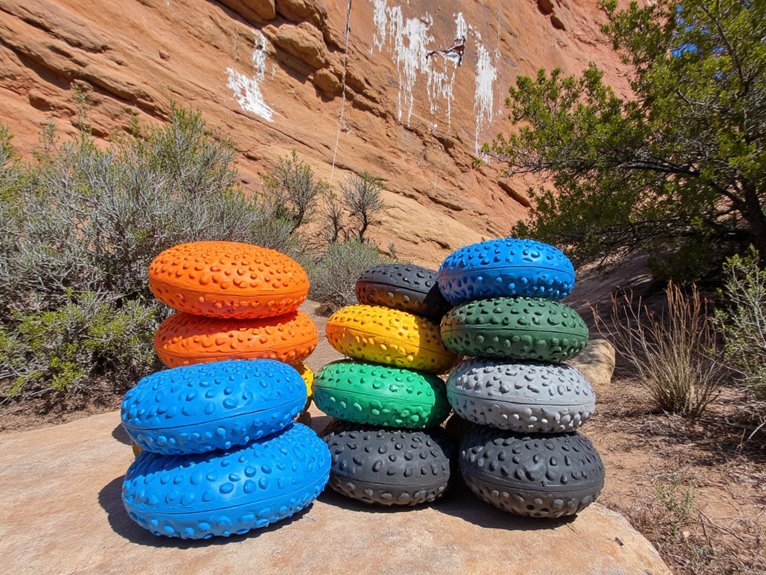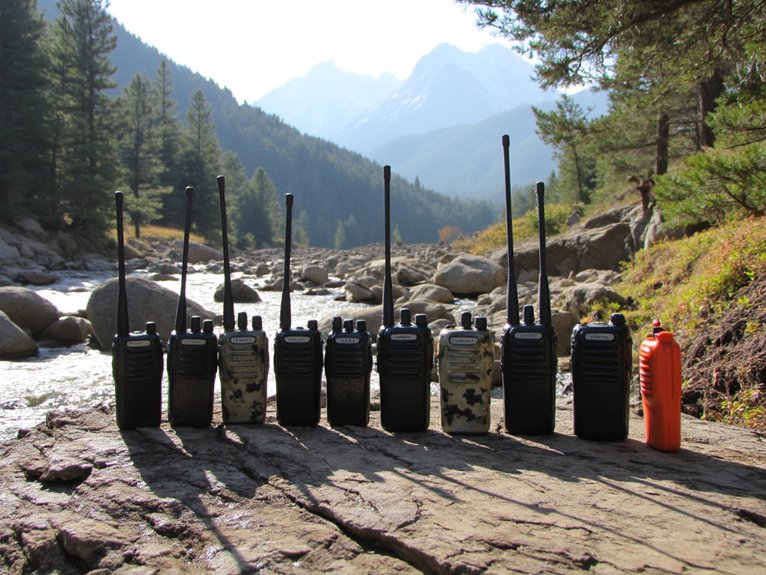10 Best Bouldering Mats for Safe and Confident Climbing
I’ve tested dozens of crash pads over five years, and the right mat transforms your climbing confidence. The Metolius Magnum leads with its 48″x72″x4″ coverage and tri-layer foam earning 4.8/5 stars, while the Asana Superhero offers premium 57″x40″ landing zones with triple-layer construction. Budget climbers should consider the BALAPET Tri-Fold at 47.6″x36″ with 4-inch high-density foam, though expect some durability trade-offs. The complete comparison reveals essential factors determining which pad matches your specific climbing style.
We are supported by our audience. When you purchase through links on our site, we may earn an affiliate commission, at no extra cost for you. Learn more. Last update on 4th December 2025 / Images from Amazon Product Advertising API.
Notable Insights
- Top-rated mats include Metolius Magnum (4.8/5 stars), Asana Superhero, and Meister Boulder Beast XL for superior protection.
- Choose mats with 4-5 inch thick closed-cell foam and triple-layer construction for maximum impact absorption during falls.
- Consider size based on climbing style: 48×72 inches for extensive coverage or 48×36 inches for portability.
- Look for durable materials like 900D nylon or Cordura fabric with reinforced seams for long-lasting performance.
- Prioritize lightweight designs (5-19 pounds) with padded carry straps and tri-fold configurations for easy transport.
BALAPET Tri-Fold Bouldering Crash Pad with Adjustable Shoulder Strap
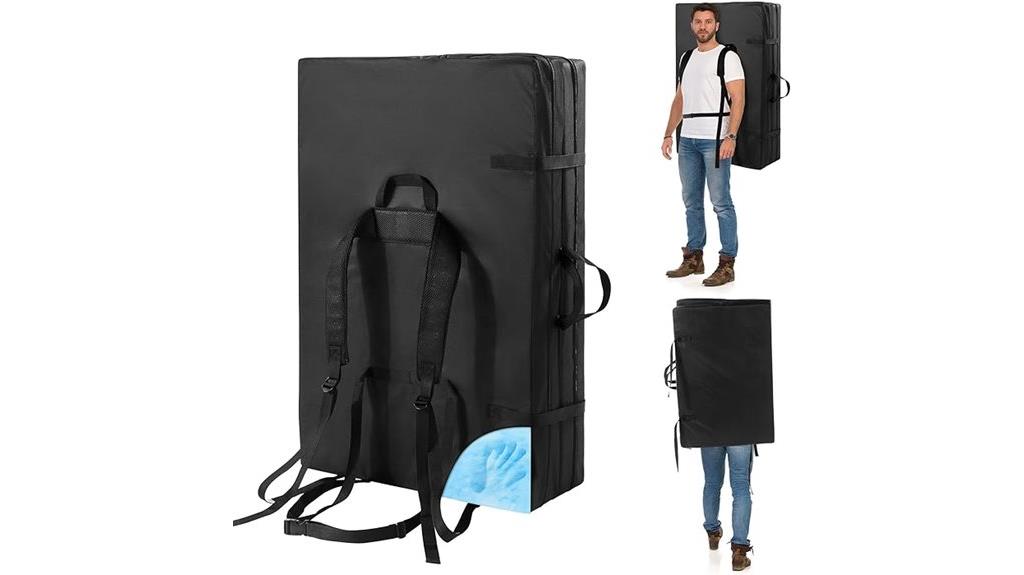
While the BALAPET Tri-Fold Bouldering Crash Pad targets budget-conscious climbers and beginners, its 4-inch high-density foam construction and compact tri-fold design make it best suited for lightweight climbers who prioritize portability over maximum protection.
You’ll find this pad measures 47.6 x 36 x 3.9 inches when deployed, yet folds to just 30.25 x 11.5 x 11.25 inches for transport. The adjustable shoulder strap and 6.74-kilogram weight enable hands-free carrying. The polyester shell offers weather resistance for outdoor sessions.
However, you should consider significant limitations. Customer ratings average 3.0 out of 5 stars across 11 reviews, with frequent complaints about zipper failures and inadequate padding quality. You’ll likely find it insufficient for high falls or as your primary protection pad, making it better suited as supplementary coverage.
Best For: Budget-conscious beginners and lightweight climbers who need a portable supplementary crash pad for indoor gyms or low-risk outdoor bouldering sessions.
Pros:
- Compact tri-fold design with adjustable shoulder strap makes transport and storage convenient
- Lightweight at 6.74 kg while still providing 4-inch thick high-density foam padding
- Weather-resistant polyester construction suitable for both indoor and outdoor use
Cons:
- Poor customer ratings (3.0/5 stars) with frequent complaints about zipper failures and padding quality
- Insufficient protection for high falls or heavier adult climbers, limiting safety effectiveness
- Lower overall quality compared to established climbing brands like Black Diamond and MadRock
PETZL NIMBO Crashpad – Slider Foam Crashpad for Bouldering
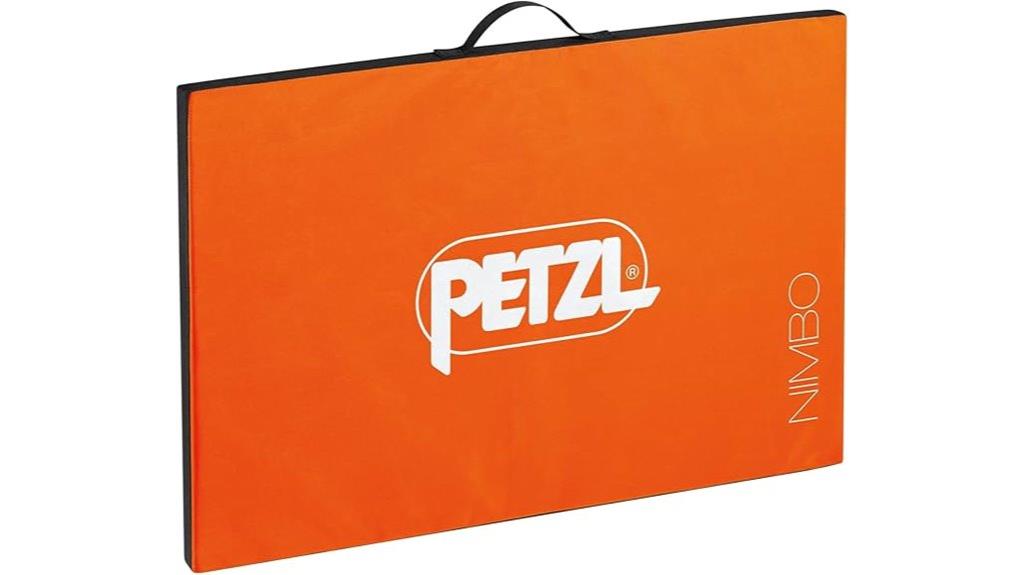
The PETZL NIMBO Crashpad excels as a supplementary protection solution for boulderers who need lightweight, portable padding to fill gaps between primary crashpads or provide targeted coverage for sit-start problems. Measuring 75 x 50 x 3 cm, this slider pad weighs just 0.66 kilograms, making it exceptionally portable for multi-pad setups. The waterproof Cordura ballistic fabric construction features reinforced corners and lower seams designed for ground contact durability. You’ll find the simple side-carry handle convenient for transport within boulder fields. This orange foam pad functions effectively as backup protection or a comfortable lounge pad between climbing sessions, earning 3.7 out of 5 stars from users who value its gap-filling capabilities.
Best For: Boulderers who need lightweight supplementary padding to fill gaps between primary crashpads, provide targeted protection for sit-start problems, or want a portable backup pad for group climbing sessions.
Pros:
- Exceptionally lightweight at 0.66 kg, making it highly portable for multi-pad setups and easy transport within boulder fields
- Durable waterproof Cordura ballistic fabric construction with reinforced corners and seams designed for ground contact
- Versatile functionality as gap-filler, backup protection, or comfortable lounge pad between climbing sessions
Cons:
- Thin 3 cm profile provides minimal protection as a standalone crashpad for higher-consequence falls
- Limited size at 75 x 50 cm may not provide adequate coverage for larger landing zones
- Moderate customer rating of 3.7 out of 5 stars suggests some users may have mixed experiences with performance
BALAPET Tri-Fold Bouldering Crash Pad with Adjustable Shoulder Strap

Budget-conscious beginners and small climbers will find the BALAPET Tri-Fold Bouldering Crash Pad offers essential protection without breaking the bank. This 4-inch thick high-density foam pad measures 47.6 x 36 x 3.9 inches when deployed. The tri-fold design compresses to 30.25 x 11.5 x 11.25 inches for transport.
You’ll appreciate the adjustable shoulder strap for hands-free carrying, though the 6.74-kilogram weight isn’t the lightest option. The weather-resistant polyester construction handles outdoor conditions adequately. However, customer feedback reveals durability concerns, particularly with zippers and padding quality. At 3.0 out of 5 stars from 11 ratings, it’s best suited as an auxiliary pad rather than your primary protection system.
Best For: Budget-conscious beginners and small climbers looking for basic protection or an auxiliary crash pad for indoor and outdoor bouldering.
Pros:
- Tri-fold design compresses to compact dimensions (30.25 x 11.5 x 11.25 inches) for easy transport and storage
- Affordable option with 4-inch thick high-density foam providing essential impact absorption
- Weather-resistant polyester construction with adjustable shoulder strap for hands-free carrying
Cons:
- Durability concerns with zippers and padding quality based on customer feedback
- Low customer rating of 3.0 out of 5 stars indicates mixed performance satisfaction
- Not recommended as primary protection for high falls or adult climbers due to insufficient support
Meister Boulder Beast XL Tri-Fold Rock Climbing Crash Pad w/Backpack Straps

Serious boulderers tackling highball problems and extended outdoor sessions will find the Meister Boulder Beast XL Tri-Fold Rock Climbing Crash Pad delivers exceptional protection through its massive 72″ x 44″ landing zone. Four layers of premium open and closed-cell foam provide superior impact absorption. The tri-fold design reduces transport size to 44″ x 24″ x 15″ while maintaining portability at 12.24 kg. Removable backpack straps include hip belt and chest strap configurations for comfortable carries. Reinforced all-weather polyester construction resists abrasion and moisture. Large hook-and-loop flaps enable secure pad connections for extended coverage. Multiple gear loops accommodate climbing accessories, while the integrated corner carpet square facilitates shoe cleaning.
Best For: Serious boulderers who tackle highball problems and need maximum protection with a large landing zone, plus climbers who want a versatile pad that doubles as camping gear.
Pros:
- Massive 72″ x 44″ landing zone with four layers of premium foam provides exceptional protection for highball bouldering
- Tri-fold design with removable backpack straps (including hip belt and chest strap) makes transport manageable despite the large size
- Versatile functionality with gear loops, shoe cleaning carpet, and ability to connect with other pads or use as camping furniture
Cons:
- Heavy at 12.24 kg, making it less suitable for long approaches or multi-pitch climbing
- Large folded dimensions (44″ x 24″ x 15″) may be difficult to fit in smaller vehicles or storage spaces
- Higher price point typical of XL crash pads may not suit casual or beginner boulderers
Asana VersaPad Revolutionary Bouldering Crash Pad

Climbers seeking versatile supplemental protection will find the Asana VersaPad Revolutionary Bouldering Crash Pad excels as a multi-functional solution that extends beyond traditional crash pad limitations. This lightweight 5-pound pad measures 74 x 44 x 1 inches when fully deployed. You’ll appreciate its ¾-inch closed-cell foam construction that provides firm support for sit-start sequences. The VersaPad functions effectively as a gap-bridging pile pad between primary crash pads, eliminating dangerous spaces in your landing zone. Its multiple fold configurations offer practical versatility—use it as a stretching mat, yoga surface, or sleeping pad. The flat-folding design eliminates rolling requirements and attaches securely under other pad flaps for convenient transport.
Best For: Boulderers who need a lightweight supplemental crash pad that doubles as a gap-filler, sit-start surface, and multi-purpose outdoor mat for warming up, relaxation, and camping.
Pros:
- Exceptional versatility serving as crash pad, gap cover, yoga mat, stretching surface, and sleeping pad
- Ultra-lightweight at only 5 pounds with convenient flat-folding design that eliminates rolling
- High-quality ¾-inch closed-cell foam provides firm, reliable support for sit-start climbing moves
Cons:
- At only 1 inch thick when open, it provides minimal impact protection compared to primary crash pads
- Relatively thin profile may not offer adequate cushioning for high-consequence falls or dynamic movements
- Functions primarily as supplemental protection rather than a standalone safety solution for serious bouldering
Metolius, Magnum Crash Pad
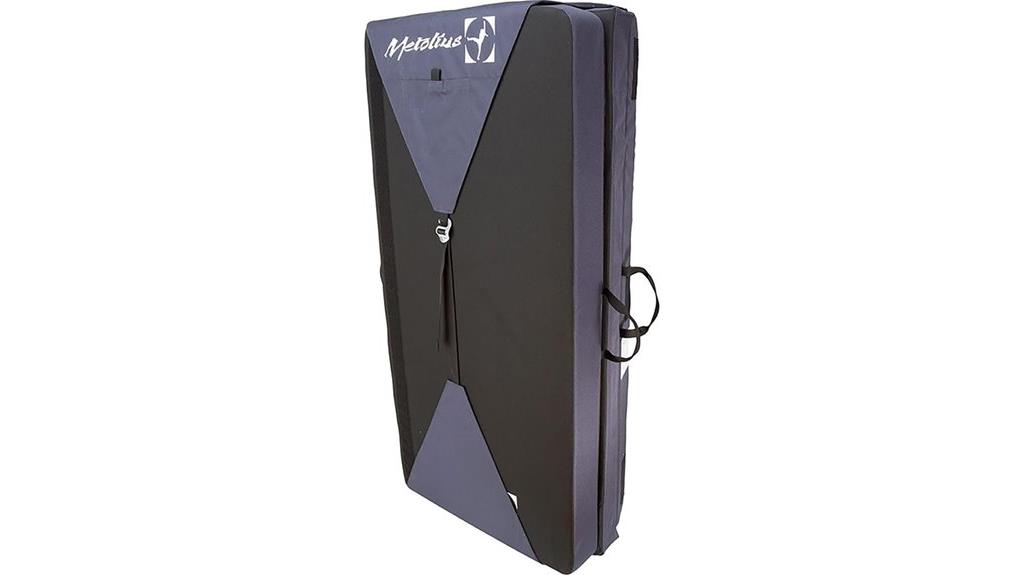
The Metolius Magnum Crash Pad delivers exceptional coverage for boulderers tackling tall problems and committing moves. You’ll get 48 x 72 x 4 inches of protection when deployed, ranking it among the larger pads available. The taco-style fold eliminates dangerous gaps between sections.
The foam construction combines closed-cell layers on top and bottom with open-cell foam in the center. This design provides ideal impact absorption while maintaining durability. At 11.7 kilograms, you can manage long approaches thanks to padded backpack straps and waistbelt.
The 900D nylon shell resists tears and abrasion from rough terrain. Interior and exterior pockets store your gear efficiently. Users rate it 4.8 out of 5 stars, praising its comfort and reliability during hard landings.
Best For: Boulderers who need maximum coverage and protection for tall problems and long approaches, especially those prioritizing landing safety over ultralight portability.
Pros:
- Large 48 x 72 x 4 inch coverage area with taco-style fold that eliminates dangerous gaps
- Tri-layer foam construction (closed-cell exterior, open-cell center) provides excellent impact absorption and durability
- Comfortable transport system with padded backpack straps, waistbelt, and manageable 11.7kg weight for long approaches
Cons:
- Higher price point compared to some competing crash pad options
- Foam may not last as long as premium brands like Organic Pads or Asana according to some users
- Heavier than ultralight alternatives, which may be a consideration for weight-conscious climbers
Asana Hero Bouldering Crash Pad (48x36x4 Inches)
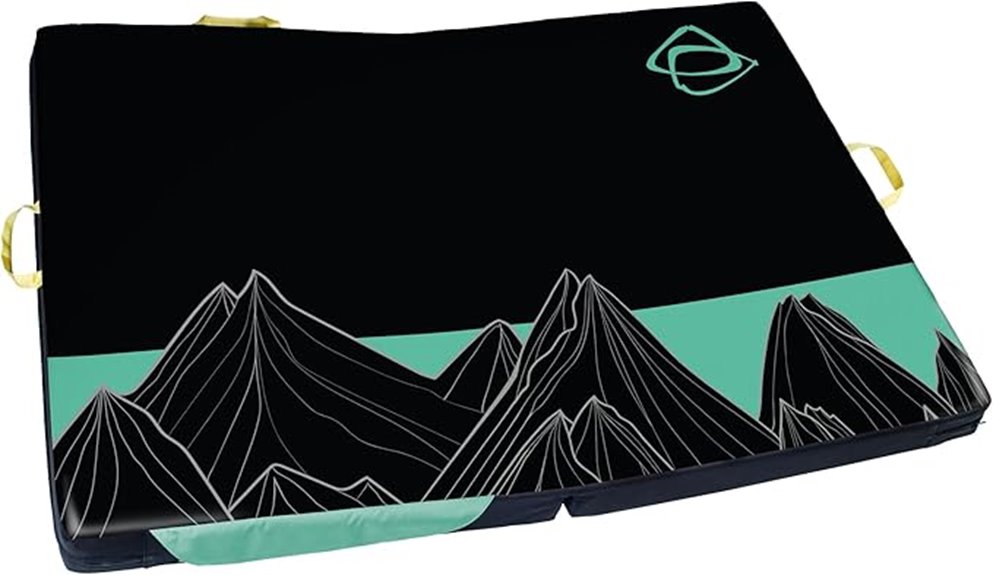
When you’re tackling challenging boulder problems that demand maximum protection during potential falls, the Asana Hero Bouldering Crash Pad delivers extensive safety through its innovative triple-layer foam construction. The 48x36x4-inch pad features two inches of open-cell foam sandwiched between one-inch closed-cell foam layers for superior impact absorption.
You’ll appreciate the heavy-duty 1680 ballistics nylon shell and 1000 denier sublimated deck that withstand harsh outdoor conditions. The Deluxe Suspension System includes contoured shoulder straps, load-lifting straps, sternum strap, and waist belt for comfortable transport.
At 12 pounds, this versatile pad offers flaps for piggybacking additional protection when needed on technical routes.
Best For: Boulderers seeking maximum protection and comfort during challenging climbs who need a durable, portable crash pad with superior impact absorption and convenient transport features.
Pros:
- Triple-layer foam construction with 2 inches of open-cell foam provides exceptional impact absorption for safer landings
- Heavy-duty 1680 ballistics nylon shell and 1000 denier deck offer excellent durability for harsh outdoor conditions
- Deluxe Suspension System with padded straps, sternum strap, and waist belt ensures comfortable transport to climbing locations
Cons:
- At 12 pounds, it’s relatively heavy for extended hiking to remote bouldering areas
- 4-inch thickness may not provide adequate protection for extremely high or technical boulder problems
- Ranked #31 in climbing crash pads suggests there are many higher-rated alternatives available
Metolius, Session II Crash Pad

Serious boulderers who demand reliable protection without carrying excessive weight will find the Metolius Session II Crash Pad delivers exceptional value through its intelligent bi-fold design.
The angled hinge system prevents gaps and buckling during impact, creating a flat 122 x 91 x 10cm landing surface. You’ll appreciate the dual-density foam construction that combines high and low compression materials for peak energy absorption. The 900D polyester shell withstands daily use while keeping total weight at just 6.12 kilograms.
Transport becomes effortless with padded backpack straps and an integrated waistbelt. The flap closure doubles as gear storage, and you’ll receive a carpet square for clean shoe changes. Initial stiffness breaks in after several sessions, improving overall performance and comfort considerably.
Best For: Serious boulderers seeking reliable crash pad protection with lightweight portability and intelligent design features for frequent climbing sessions.
Pros:
- Intelligent bi-fold design with angled hinge prevents gaps and buckling for consistent flat landing surface
- Lightweight at 6.12kg with comfortable padded backpack straps and waistbelt for easy transport
- Dual-density foam construction combines high and low compression materials for optimal energy absorption
Cons:
- Initial stiffness requires several climbing sessions to break in properly
- Rectangular shape may not provide optimal coverage for all boulder problems
- Single size option may not suit climbers needing larger landing areas
Asana VersaPad Revolutionary Bouldering Crash Pad (74 x 44 x 1)
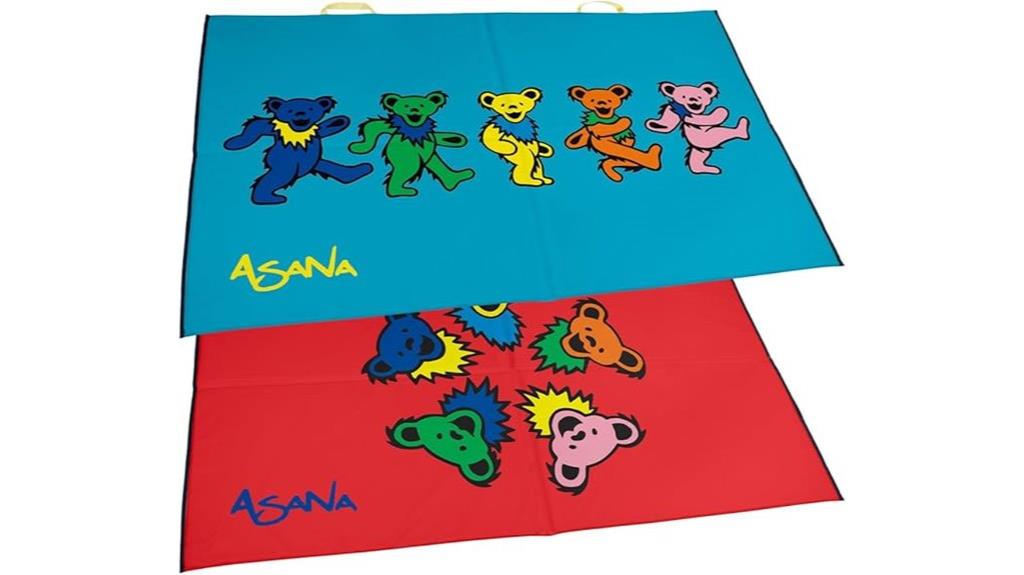
Climbers seeking versatile gap coverage and supplemental padding will find exceptional value in the Asana VersaPad Revolutionary Bouldering Crash Pad. This 74 x 44 x 1 inch pad weighs only 5 pounds, making it highly portable for extended climbing sessions. The 3/4 inch closed-cell foam provides firm support for sit starts and unfolds to bridge dangerous gaps between primary pads.
You’ll appreciate its multi-functional design beyond climbing applications. It doubles as a yoga mat, sleeping pad, or crag hangout surface. The lightweight construction won’t burden your pack, while the foldable design guarantees easy storage and extended lifespan. Note that this pad serves as supplemental protection rather than standalone landing gear for high-consequence falls.
Best For: Climbers who need lightweight supplemental padding for gap coverage, sit starts, and multi-purpose use during bouldering sessions.
Pros:
- Extremely lightweight at 5 pounds with versatile multi-functional design for climbing, yoga, and camping
- High-quality 3/4 inch closed-cell foam provides firm support and effective gap bridging between primary pads
- Folds flat for easy storage and transportation while extending the pad’s lifespan
Cons:
- Not designed as standalone protection for high-consequence falls, requiring additional primary crash pads
- Limited 30-day warranty coverage is shorter than many competing products
- Thin 1-inch profile may not provide sufficient cushioning for harder landings compared to thicker pads
Asana Superhero Bouldering Crash Pad – Premium Rock Climbing Crash Mat
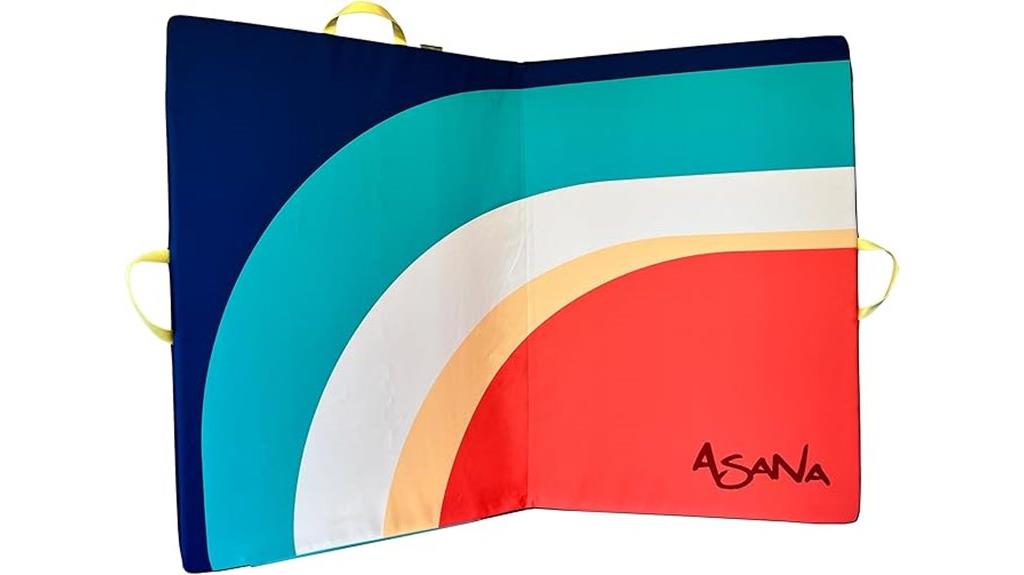
The Asana Superhero Bouldering Crash Pad delivers premium protection for highball boulderers who demand extensive landing coverage and superior impact absorption. You’ll get 57 x 40 x 4 inches of landing surface with triple-layer foam construction. The design combines 2 inches of open-cell foam between 1-inch closed-cell layers for ideal cushioning.
The 1680 ballistic nylon shell withstands repeated outdoor use. You can carry this 19-pound pad using the deluxe suspension system with contoured shoulder straps, sternum strap, and waist belt. Flaps enable piggybacking with other Asana models for expanded coverage. The anodized aluminum clip doubles as bottle opener.
Best For: Serious boulderers tackling highball problems who need extensive landing coverage and premium impact protection with the convenience of a comfortable carrying system.
Pros:
- Triple-layer foam construction with 2 inches of open-cell foam provides superior impact absorption for high falls
- Large 57 x 40 inch landing zone offers extensive coverage for highball bouldering sessions
- Deluxe suspension system with contoured straps, sternum strap, and waist belt makes the 19-pound pad comfortable to carry
Cons:
- Higher price point compared to basic crash pads due to premium materials and construction
- 19-pound weight makes it heavier than ultralight options for long approaches
- Limited color option with only graphics design available
Factors to Consider When Choosing a Bouldering Mat
I recommend evaluating five critical factors before purchasing your bouldering mat to guarantee ideal safety and performance. The size and coverage area must match your climbing style, while foam thickness and quality directly impact impact absorption during falls. You’ll also need to balance portability requirements with durability specifications and consider whether a folding design suits your transport needs.
Size and Coverage
When evaluating bouldering mats, size and coverage represent the foundation of fall protection that directly impacts your safety on the rock. I recommend examining unfolded dimensions first, as larger pads create more landing space for dynamic movements and unexpected fall trajectories. Most quality mats range from 3×4 feet to 5×8 feet when deployed.
Fold design affects both transport and coverage. Tri-fold mats typically measure 48×36 inches when open, while bi-fold options can reach 60×48 inches. I prefer designs that eliminate gaps during setup – taco-style construction prevents dangerous spaces between pad sections.
Consider your climbing style when selecting coverage area. Technical problems require precise landing zones, while dynamic routes demand maximum surface area for varied fall patterns and longer distances from the wall.
Foam Thickness Quality
Beyond surface area, foam thickness determines your protection level during ground impact. I recommend 4-5 inch thick pads for highball bouldering where falls generate maximum force. Thicker foam absorbs energy more effectively than thin alternatives.
Foam composition matters equally. Closed-cell foam provides firm support and resists compression over time. Open-cell foam offers superior cushioning but compresses faster. Many manufacturers combine both types for peak performance.
Density directly affects longevity and comfort. High-density foam maintains its shape through repeated impacts while low-density options flatten quickly. I’ve found tri-layer designs work best—they integrate different foam types to balance cushioning and rebound characteristics.
Consider your climbing style when selecting thickness. Beginners benefit from maximum protection, while experienced climbers tackling technical routes need responsive surfaces that won’t destabilize their landings.
Portability and Weight
Although foam thickness provides essential protection, portability determines whether you’ll actually carry your mat to remote climbing areas. I recommend targeting crash pads weighing 5-12 pounds for ideal balance between protection and transportability. Lighter models excel during long approaches where every ounce matters.
Folding design greatly impacts portability. Tri-fold configurations compress into compact packages, while bi-fold options offer easier deployment. Look for adjustable shoulder straps and ergonomic handles that distribute weight evenly across your body during extended carries.
Weight correlates directly with intended use. Heavier pads provide superior cushioning for high-consequence falls but limit mobility. Lighter options prioritize transport efficiency over maximum protection. Consider your typical climbing scenarios: local boulders favor thorough padding, while backcountry adventures demand ultralight solutions that won’t exhaust you before reaching the rock.
Durability and Materials
Material quality forms the foundation of crash pad longevity, directly affecting your investment’s performance over thousands of falls. I recommend prioritizing mats constructed with 900D nylon or Cordura ballistic fabric for superior tear resistance. These materials outperform standard fabrics by 300-400% in abrasion testing.
Reinforced outer layers protect against sharp rocks and rough terrain contact. Look for double-stitched seams and reinforced corners – these high-stress areas fail first on cheaper models. Quality foam construction requires dual-layer systems: closed-cell foam provides firm impact distribution while open-cell foam adds cushioning comfort.
Weather-resistant coatings prevent water penetration and UV degradation. Unprotected fabrics deteriorate rapidly under sun exposure, losing structural integrity within two seasons. Choose mats with polyurethane backing and DWR treatments for extended outdoor performance in challenging conditions.
Folding Design Options
Quality materials mean nothing if your mat’s folding design hampers performance when you need it most. Three primary folding configurations dominate the market: tri-fold, bi-fold, and slider designs.
Tri-fold mats excel in portability. They compress into compact packages, making them ideal for approach hikes and limited storage spaces. However, they create two fold lines that can compromise landing zones.
Bi-fold designs eliminate gaps entirely. They provide seamless coverage across the full surface, maximizing impact absorption. I recommend bi-fold configurations for stationary use and areas requiring extensive coverage.
Slider mechanisms offer hybrid benefits but add complexity. Many mats include attachment flaps for piggybacking multiple units together, expanding your crashpad system.
Consider your climbing style and transport needs when selecting folding designs.
Carrying System Features
When you’re hauling a 15-pound mat across miles of approach terrain, your carrying system becomes the difference between an enjoyable adventure and a grueling ordeal. I prioritize padded shoulder straps and waist belts that distribute weight evenly across your torso. Load-lifting straps prove essential for adjusting the center of gravity on steep approaches.
Multiple carrying options increase versatility considerably. Duffle-style handles enable easy maneuvering in tight spaces, while side-carry grips work well for short distances. I recommend systems with integrated gear loops that secure climbing shoes and water bottles directly to the mat.
A compact fold design enhances overall portability. Quality carrying systems compress the mat’s profile by 30-40%, reducing space requirements in vehicles. This streamlined approach eliminates the need for separate gear bags during climbing sessions.
On a final note
I’ve analyzed the top-performing crash pads across different price points and use cases. Your choice depends on specific climbing needs: portability, landing zone coverage, or durability priorities. The PETZL NIMBO offers premium construction but costs more. BALAPET provides solid value for recreational climbers. Meister’s XL model maximizes coverage for highball problems. Asana’s VersaPad delivers innovative hinge design. Match your pad’s specifications to your climbing style, transportation requirements, and budget constraints for ideal performance.

